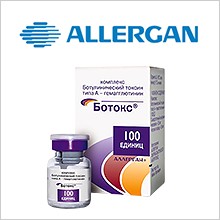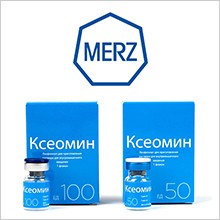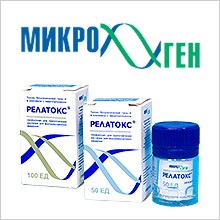Библиотека специалиста
Прошедшие Статьи
n|a
Content of Botulinum Neurotoxin in Botox/Vistabel, Dysport/Azzalure , and Xeomin/Bocouturen (ENG)
To determine the amount of BoNT/A protein present in pharmaceutical preparations of Botox®, Dysport®, and Xeomin®, which are identical with Vistabel®, Azzalure®, and Bocouture®, respectively.
n|a
Functional influence of botulinum neurotoxin type A treatment (Xeomin®) of multifocal upper and lower limb spasticity on chronic hemiparetic gait (ENG)
This report describes the modification of hemiplegic shoulder pain and walking velocity through injections of Xeomin®, a new botulinum neurotoxin type A formulation, in a 67-year-old woman with chronic residual left hemiparesis and hemiparetic gait attributable to stroke. Clinical evaluation included upper and lower limb spasticity, upper and lower limb pain, trunk control, upper and lower limb motricity index, visual gait analysis, and gait velocity. Assessments were performed before, 1 week after, and 1 month after treatment. Improvement was observed in all clinical parameters assessed. Amelioration of spasticity of the upper and lower limbs and shoulder pain was observed after 1 month. Trunk postural attitude and paraxial muscle recruitment recovered. No adverse events were observed and the patient shows significant improvement of functional impairment derived from chronic spasticity after treatment with Xeomin®. We also provide a simple and useful protocol for clinical evaluation of the treatment.
n|a
Studies on the dissociation of botulinum neurotoxin type A complexes (ENG)
The neurotoxins produced by the various strains of the anaerobic bacterium Clostridium botulinum naturally occur associated with complexing proteins which serve to protect the neurotoxins from the harsh environment of the mammalian gastrointestinal tract during bacterial invasion of the host. Three different complex species with the discrete sizes 19S (900 kDa, LL complex), 16S (500 kDa, L complex) and 12S (300 kDa, M complex) may be isolated from C. botulinum type A cultures. However, to affect their target cells these complexes must dissociate releasing the free 150 kDa neurotoxin. This study assesses the stability of these Clostridium botulinum neurotoxin serotype A (BoNT/A) complexes and identifies factors which influence their dissociation. The knowledge gained with purified toxin complexes was subsequently employed to analyze the presence of such complexes in the freeze or spray-dried commercial BoNT/A products Botox and Dysport in comparison to the complexing protein free product Xeomin. Purified 900 kDa and 500 kDa toxin complex preparations show a pH and time dependent release of the 150 kDa neurotoxin with a half-life of less than a minute at pH values >7.0. At pH values of 6.25 or less, the complexes are stable. Furthermore, dilution of concentrated 900 kDa complexes leads to dissociation into 500 kDa, neurotoxin containing complexes. Addition of sodium chloride as contained in isotonic saline leads to further disruption of these complexes resulting in the release of the free 150 kDa neurotoxin. Examination of the commercial botulinum neurotoxin products Botox and Dysport using the same analytical procedures leads to the same conclusion: the dilution, drying and reconstitution processes of these products lead to a complete dissociation of 900 kDa complexes and 85% or more of neurotoxin are present in free form.
n|a
Measuring the potency labelling of onabotulinumtoxinA (Botox) and incobotulinumtoxinA (Xeomin) in an LD50 assay (ENG)
The biological potency of botulinum toxin (BT) drugs is determined by a standardised LD50 assay. However, the potency labelling varies vary amongst different BT drugs. One reason for this may be differences in the LD50 assays applied. When five unexpired batches of onabotulinumtoxinA (Botox(®)) and incobotulinumtoxinA (Xeomin(®)) are compared in the Xeomin(®) batch release assay, the potency variability of both BT drugs fell within the range allowed by the European Pharmacopoiea. Statistical analyses failed to detect differences in the potency labelling of both products.
n|a
Five-year experience with incobotulinumtoxinA (Xeomin): the first botulinum toxin drug free of complexing proteins (ENG)
In 2005, incobotulinumtoxinA (Xeomin(®) ), a new botulinum toxin (BT) type A drug without complexing proteins (CPs), became available. This paper reviews the specific features of Xeomin(®) and the experience gathered with it during the last 5 years. Compared with conventional BT drugs, Xeomin(®) 's extended shelf live and its simplified temperature restrictions indicate that CPs are not necessary for BT drug stability. Its reduced molecular size does not translate into diffusion differences, and its potency labelling is identical to that of onabotulinumtoxinA (Botox(®) ). With a reduced content of inactivated botulinum neurotoxin, Xeomin(®) should have reduced antigenicity. Lack of CP's may further reduce antigenicity. Xeomin(®) 's therapeutic efficacy against cervical dystonia, blepharospasm and spasticity has been proven in large randomised, double-blind and placebo-controlled studies leading to registrations in many countries.
n|a
Assay of diffusion of different botulinum neurotoxin type a formulations injected in the mouse leg (ENG)
Botulinum neurotoxin type-A (BoNT/A) is very effective in the therapy of a wide range of human syndromes characterized by hyperactivity of peripheral cholinergic nerve terminals. Little diffusion of this toxin from the site of injection is commonly observed, but even minor changes in this property would greatly affect the validity of the treatment. Different pharmacological formulations of BoNT/A are available, and they may have different diffusion characteristics due to protein complex size, product format, and pharmacological properties. Here we assessed the extent of diffusion of three commercial preparations of BoNT/A: Botox (Allergan), Dysport (Ipsen), and Xeomin (Merz Pharmaceuticals) using a novel and highly sensitive test based on neural cell adhesion molecule (N-CAM) expression in muscle. N-CAM is a membrane glycoprotein that accumulates on muscle fibers after denervation and is not expressed in untreated adult muscle.
n|a
Complexing proteins in botulinum toxin type A drugs: a help or a hindrance?
Studies have shown that Xeomin is not associated with the development of neutralizing antibodies in animal models or in patients. In conclusion, complexing proteins do not contribute to the stability of botulinum toxin type A drugs and do not contribute to their therapeutic effects, but may be associated with a secondary nonresponse due to the development of neutralizing antibodies.
n|a
Clinical Relevance of Botulinum Toxin Immunogenicity (ENG)
This review presents what is currently known about the immunogenicity of botulinum toxin and how this impacts upon patient non-response to treatment. The complexing proteins may act as adjuvants and stimulate the immune response. Their role and that of neutralizing and non-neutralizing antibodies in the response to botulinum toxin is discussed, together with an assessment of current neutralizing antibody measurement techniques.
n|a
Efficacy and safety of NT 201 for apper limb spasticity of various etiologies - a randomized parallel-group stydy (ENG)
To assess efficacy and safety of two dilutions of botulinum neurotoxine type A NT 201 (Xeomin) in patients wiht apper limb spasticity of diverse etiology.
n|a
Occurence and Clinical Predictors of Spasticity After Ischemic Stroke (ENG)
There is currently no consensus on (1) the percentage of patients who develop spasticity after ischemic stroke, (2) the relation between spasticity and initial clinical findings after acute stroke, and (3) the impact of spasticity on activities of daily living and health-related quality of life.








